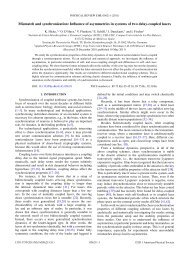DBI Analysis of Open String Bound States on Non-compact D-branes
DBI Analysis of Open String Bound States on Non-compact D-branes
DBI Analysis of Open String Bound States on Non-compact D-branes
You also want an ePaper? Increase the reach of your titles
YUMPU automatically turns print PDFs into web optimized ePapers that Google loves.
CHAPTER 3. SUPERSTRINGS 443.4 Quantizati<strong>on</strong> and spectrumTurning to the quantizati<strong>on</strong> <str<strong>on</strong>g>of</str<strong>on</strong>g> these strings, we will again start by promoting the expansi<strong>on</strong>modes to quantum operators using the can<strong>on</strong>ical formalism, switching to (spacetime)light-c<strong>on</strong>e gauge in order to c<strong>on</strong>struct the spectra.First thing to note is that the behaviour <str<strong>on</strong>g>of</str<strong>on</strong>g> the bos<strong>on</strong>ic degrees <str<strong>on</strong>g>of</str<strong>on</strong>g> freedom has notchanged, and as a c<strong>on</strong>sequence, also the quantizati<strong>on</strong> <str<strong>on</strong>g>of</str<strong>on</strong>g> their modes remains the same,i.e.[α µ m, α ν n] = [˜α µ m, ˜α ν n] = mδ m+n,0 η µν ; [α µ m, ˜α ν n] = 0. (3.29)We could have instead chosen to use a instead <str<strong>on</strong>g>of</str<strong>on</strong>g> α, in which case the above relati<strong>on</strong>sbecome[a µ m, a ν n] = [ã µ m, ã ν n] = δ m+n,0 η µν ; [a µ m, ã ν n] = 0. (3.30)The behaviour <str<strong>on</strong>g>of</str<strong>on</strong>g> the fermi<strong>on</strong>ic modes is very similar, the biggest difference being thatthey obey anticommutati<strong>on</strong> relati<strong>on</strong>s instead <str<strong>on</strong>g>of</str<strong>on</strong>g> commutati<strong>on</strong> relati<strong>on</strong>s, as a c<strong>on</strong>sequence<str<strong>on</strong>g>of</str<strong>on</strong>g> them being fermi<strong>on</strong>ic. As such, the quantizati<strong>on</strong> prescripti<strong>on</strong> becomes{. . .,...} −→ −i {. . .,...} , (3.31)where the left anticommutator represents the classical <strong>on</strong>e, and the <strong>on</strong>e <strong>on</strong> the right isthe quantum versi<strong>on</strong>. We also note that the fact that ψ µ are Majorana spinors getsinherited by the modes in that sense that they need to satisfy the c<strong>on</strong>diti<strong>on</strong>(b µ r) † = b µ −r ; (d µ r) † = d µ −r , (3.32)and analogous for their tilded brethren. The result <str<strong>on</strong>g>of</str<strong>on</strong>g> all this are the following relati<strong>on</strong>s:}{ }{b µ r,b ν s} ={˜bµ r ,˜b ν s = η µν δ r+s ; b µ r,˜b ν s = 0, (3.33){{d µ m, d ν n} = ˜dµ m , ˜d}{νn = η µν δ m+n ; d µ m, ˜d}νn = 0. (3.34)Notice that the b µ and ˜b µ operators do not c<strong>on</strong>tain a zero mode.Before moving <strong>on</strong> to the spectrum, and although we will not go into the details, wementi<strong>on</strong> that also in the superstring case <strong>on</strong>e can expand the energy-momentum tensor,as well as the supercurrent coming from the global world sheet supersymmetry. Themodes <str<strong>on</strong>g>of</str<strong>on</strong>g> these expansi<strong>on</strong>s form the super-Virasoro algebra. Furthermore, also analogousto the bos<strong>on</strong>ic string case, up<strong>on</strong> normal ordering <str<strong>on</strong>g>of</str<strong>on</strong>g> the modes <strong>on</strong>e induces two orderingc<strong>on</strong>tants a R and a NS , respectively for the Ram<strong>on</strong>d and Neveu-Schwarz sectors. Byplaying a clever game involving the super-Virasoro algebra and physical states, <strong>on</strong>e canderive the results that a R = 0, a NS = 1 2and D = 10 for superstrings. The same resultcould be obtained by first c<strong>on</strong>structing the spectrum <str<strong>on</strong>g>of</str<strong>on</strong>g> the strings in the space-timelight-c<strong>on</strong>e gauge, and then applying a zeta-regularizati<strong>on</strong> technique similar to the <strong>on</strong>ewe saw in Chapter 2 for the bos<strong>on</strong>ic string. We will c<strong>on</strong>sider these results as known,and immediatly use them in what follows.It is worth pointing out that Eq. 3.2 still describes <strong>on</strong>e, and <strong>on</strong>ly <strong>on</strong>e, string. Wedo not get two strings: <strong>on</strong>e which behaves like a bos<strong>on</strong>, and <strong>on</strong>e which behaves like a
















